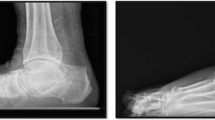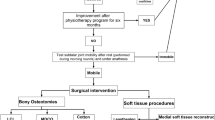Abstract
Purpose
Early stage adult acquired flatfoot deformity (AAFD) is traditionally treated with osteotomy and tendon transfer. Despite a high success rate, the long recovery time and associated morbidity are not sufficient. This study aims to evaluate the functional and radiological outcomes following the use of the arthroereisis screw with tendoscopic delivered PRP for early stage AAFD.
Methods
Patients with stage IIa AAFD who underwent the use of the arthroereisis screw with tendoscopic delivered PRP with a minimum follow-up time of 24 months were retrospectively evaluated. Clinical outcomes for pain were evaluated with the Foot and Ankle Outcomes Score (FAOS) and Visual Analog Score (VAS). Radiographic deformity correction was assessed using weight-bearing imaging.
Results
Thirteen patients (13 feet) with mean follow-up of 29.5 months were included. The mean age was 37.3 years (range, 28–65 years). FAOS-reported symptoms, pain, daily activities, sports activities, and quality of life significantly improved from 52.1, 42.6, 57.6, 35.7, and 15.4 pre-operatively to 78.5, 68.2, 83.3, 65.0, and 49.6 post-operatively, respectively (p < 0.05). Statistically significant radiographic improvements (lateral talus first metatarsal angle, calcaneal pitch, and cuneiform to ground distance) were also observed between the pre- and post-operative images.
Conclusions
This study elucidates the successful implementation of a less invasive approach to stage IIa AAFD. Through the use of a subtalar arthroereisis screw, PTT tendoscopy, and PRP injection, clinical and radiographic outcomes were improved.



Similar content being viewed by others
References
Myerson RA (1996) Instructional course lecture, The American Academy of Orthopaedic Surgeons. Adult acquired flatfoot deformity, treatment of dysfunction of the posterior tibial tendon. J Bone Joint Surg Am 78:780–792
Myerson MS, Corrigan J (1996) Treatment of posterior tibial tendon dysfunctionwith flexor digitorum tendon transfer and calcaneal osteotomy. Orthopedics 19(5):383–388
Myerson MS, Badekas A, Schon LC (2004) Treatment of stage II posterior tibial tendon deficiency with flexor digitorum longus tendon transfer and calcaneal osteotomy. Foot Ankle Int 25(7):445–450
Kou JX, Balasubramaniam M, Kippe M, Fortin PT (2012) Functional results of posterior tibial tendon reconstruction, calcaneal osteotomy, and gastrocnemius recession. Foot Ankle Int 33(7):602–611
Haeseker GA, Mureau MA, Faber FW (2010) Lateral column lengthening for acquired adult flatfoot deformity caused by posterior tibial tendon dysfunction stage II: a retrospective comparison of calcaneus osteotomy with calcaneocuboid distraction arthrodesis. J Foot Ankle Surg 49(4):380–384
Grice DS (1952) An extra-articular arthrodesis of the subastragalar joint for correction of paralytic flat feet in Children. J Bone Joint Surg Am 34:927–940
Giannini S, Ceccarelli F, Benedetti MG, Cantani F, Faldini C (2001) Surgical treatment of flexible flatfoot in children. J Bone Joint Surg 83A:73–79
Viladot R, Pons M, Alvarez F, Omaña J (2003) Subtalar arthroereisis for posterior tibial tendon dysfunction: a preliminary report. Foot Ankle Int 24(8):600–606
Zaret DI, Myerson MS (2003) Arthroerisis of the subtalar joint. Foot Ankle Clin 8(3):605–617
Needleman RL (2006) A surgical approach for flexible flatfeet in adults including a subtalar arthroereisis with the MBA sinus tarsi implant. Foot Ankle Int 27(1):9–18
Adelman VR, Szczepanski JA, Adelman RP (2008) Radiographic evaluation of endoscopic gastrocnemius recession, subtalar joint arthroereisis, and flexor tendon transfer for surgical correction of stage II posterior tibial tendon dysfunction: a pilot study. J Foot Ankle Surg 47(5):400–408
Cook EA, Cook JJ, Basile P (2011) Identifying risk factors in subtalar arthroereisis explantation: a propensity-matched analysis. J Foot Ankle Surg 50:395–401
Zhu Y, Xu XY (2015) Treatment of stage II adult acquired flatfoot deformity with subtalar arthroereises. Foot Ankle Spec 8(3):194–202
Saxena A, Via AG, Maffulli N, Chiu H (2016) Subtalar arthroereisis implant removal in adults: a prospective study of 100 patients. J Foot Ankle Surg 55(3):500–503
Zhang J, Wang JH (2010) Platelet-rich plasma releasate promotes differentiation of tendon stem cells into active tenocytes. Am J Sports Med 38(12):2477–2486
Wang A, McCann P, Colliver J, Koh E, Ackland T, Joss B, Zheng M, Breidahl B (2015) Do postoperative platelet-rich plasma injections accelerate early tendon healing and functional recovery after arthroscopic supraspinatus repair? A randomized controlled trial. Am J Sports Med 43(6):1430–1437
Gianakos AL, Ross KA, Hannon CP, Duke GL, Prado MP, Kennedy JG (2015) Functional outcomes of tibialis posterior tendoscopy with comparison to magnetic resonance imaging. Foot Ankle Int 36(7):812–819
van Dijk CN, Kort N, Scholten PE (1997) Tendoscopy of the posterior tibial tendon. Arthroscopy 13(6):692–698
Sammarco VJ (2009) Peroneal tendoscopy: indications and techniques. Sports Med Arthrosc 17(2):94–99
Mani SB, Brown HC, Nair P, Chen L, Do HT, Lyman S, Deland JT, Ellis SJ (2013) Validation of the foot and ankle outcome score in adult acquired flatfoot deformity. Foot Ankle Int 34(8):1140–1146
O’Connor K, Baumhauer J, Houck JR (2010) Patient factors in the selection of operative vs nonoperative treatment for posterior tibial tendon dysfunction. Foot Ankle Int 31:197–202
Hirose CB, Johnson JE (2004) Plantar flexion opening wedge medial cuneiform osteotomy for correction of fixed forefoot varus associated with flatfoot deformity. Foot Ankle Int 25(8):568–574
Thomas RL, Wells BC, Garrison RL, Prada SA (2001) Preliminary results comparing two methods of lateral column lengthening. Foot Ankle Int 22:107–119
Chou LW, Hsieh YL, Kuan TS, Hong CZ (2014) Needling therapy for myofascial pain: recommended technique with multiple rapid needle insertion. Biomedicine (Taipei) 4(13):Epub Aug 2
Baksh N, Hannon CP, Murawski CD, Smyth NA, Kennedy JG (2013) Platelet-rich plasma in tendon models: a systematic review of basic science literature. Arthroscopy 29(3):596–607
Author information
Authors and Affiliations
Corresponding author
Ethics declarations
Conflict of interest
The corresponding author (J.G. Kennedy ) is a consultant for Arteriocyte, Inc.; J.G. Kennedy has received research support from the Ohnell Family Foundation, Mr. and Mrs. Michael J Levitt, and Arteriocyte Inc.; J.G. Kennedy is a board member for the European Society of Sports Traumatology, Knee Surgery, and Arthroscopy, International Society for Cartilage Repair of the Ankle, American Orthopaedic Foot and Ankle Society Awards and Scholarships Committee, International Cartilage Repair Society finance board.
Rights and permissions
About this article
Cite this article
Yasui, Y., Tonogai, I., Rosenbaum, A.J. et al. Use of the arthroereisis screw with tendoscopic delivered platelet-rich plasma for early stage adult acquired flatfoot deformity. International Orthopaedics (SICOT) 41, 315–321 (2017). https://doi.org/10.1007/s00264-016-3349-2
Received:
Accepted:
Published:
Issue Date:
DOI: https://doi.org/10.1007/s00264-016-3349-2




